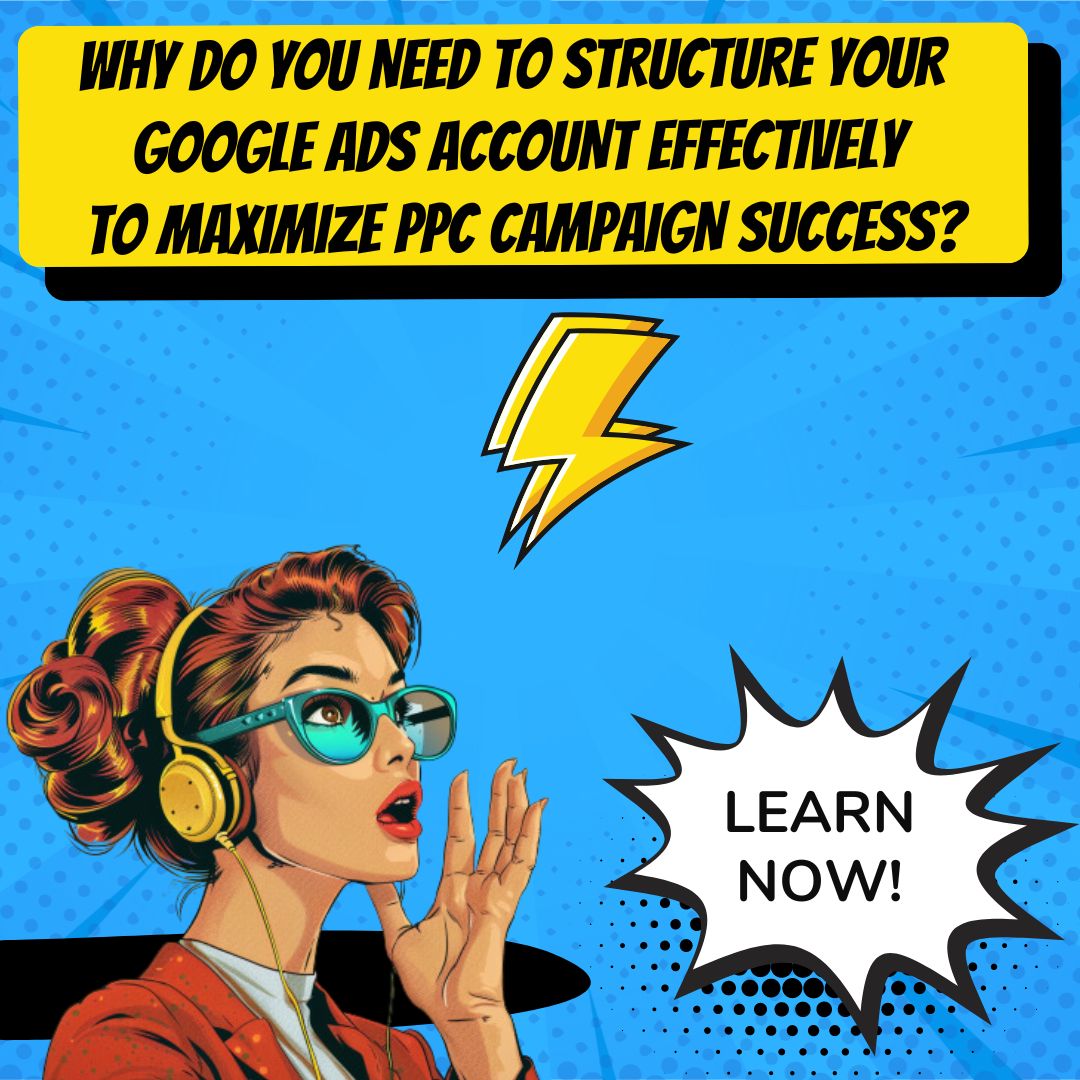Key Takeaways
✅ Proper Account Structuring is Crucial: Navigating the digital ads landscape requires a solid structure in your Google Ads account. A recent study shows that campaigns with a well-organized structure see a 20% higher ROI on average. Keep your campaigns focused, trackable, and flexible to pivot based on performance data.
✅ Campaign Structure Should Be Simple and Relevant: Simplicity is king when it comes to campaign structure. Interestingly, Google reports that campaigns with a streamlined structure witness a 30% increase in click-through rates. Maintain a tight connection between your ads and your audience's intent for better conversion rates.
✅ Customize Your Structure Based on Business Needs: Tailoring your Google Ads account structure can lead to a significant competitive edge. Stats demonstrate that customized account structures can bump up conversion rates by up to 25%. Assess your business goals and market positioning to inform your structure and drive success.

Introduction
Have you ever wondered why some businesses seem to hit the jackpot with their online ads, while others watch their budget disappear like a magician's coin trick? The answer might be simpler than you think—Structuring Your Google Ads Account for Peak PPC Campaign Performance is often the ace up their sleeve. Effective account structure could be the lever that catapults your ads from lackluster to blockbuster.
In the quest for peak PPC performance, there are patterns to the madness and secrets behind the success. This article won't just lay out the dull details—it's a treasure map to the X marking the sweet spot of your digital marketing efforts. Explore cutting-edge strategies and industry-backed tips designed to equip your campaigns with precision-guided tactics, ultimately maximizing your revenue, ROAS (Return on Ad Spend), and ROI (Return on Investment).
Pique your curiosity yet? Get ready to dive into a world of actionable insights and transform your Google Ads account from a money pit to a money printer. Keep reading, as we're about to pull back the curtain and reveal the kind of groundbreaking info that will have you clicking the "apply" button faster than you can say "impressive metrics."

Top Statistics
| Statistic | Insight |
|---|---|
| Quality Scores: Structuring by theme and using relevant keywords can improve quality scores, crucial for lower costs per click. | With ad costs rising, achieving a high Quality Score is essential for squeezing the most value out of each ad dollar spent. |
| Smart Bidding and Ad Types: Using Smart Bidding, Broad match, and Responsive Search Ads together can increase conversions by 20% at a similar cost per action. | This trio complements each other, harnessing AI and flexibility to find high-performing queries and optimize bidding in real-time. |
| Responsive Search Ads: They are now the only search ad type that can be created or edited in standard search campaigns. | Here's the new standard in Google Ads - Responsive Search Ads - adaptability and testing are key to connecting with varied user queries and preferences. |
| Ad Group Structure: Ad groups should contain 2-3 text ads and 1 responsive ad. Display ad groups should also have 2-3 ads. | Variety and testing within ad groups can lead to better performance by tailoring to user interests and improving engagement. |
| Account Structure: A well-structured account is crucial for efficient management, ad testing, and improved performance. | Like a well-organized closet, a tidy Google Ads account makes it easier to manage campaigns, allocate budget, and test ads effectively. |
Understanding Campaign Structure
When you're diving into Google Ads, think of your account as a well-organized file cabinet. Imagine drawers representing each campaign, and within those, folders as ad groups, and the documents inside are your keywords and ads. Why bother with this meticulous organization? Interestingly, a precise structure can lead to better Quality Scores, which often result in more cost-efficient clicks. It's all about grouping relevant ads, keywords, and extensions to mirror the user's intent and improve performance.

Golden Rules for Account Structure
So, what's the best way to set up your ad groups and campaigns? Adhere to a few golden rules: an ad group should contain about 15-20 keywords, directly linked to one unique landing page. Furthermore, ensure at least one active ad is running, fleshing out Search Engine Marketing strategies with a target level of conversions that justify your chosen bidding tactics. Additionally, aim to gather a minimum of 1,000 impressions on each landing page monthly to gain meaningful data for optimization.
Account Size and Budget Considerations
Size does matter — in your account structure, that is. Match your Google Ads account's scale to both the size of your budget and the complexity of your website. Tight budget? Channel your funds into campaigns for your bestsellers or most lucrative services. Also, don't overlook Dynamic Search Ads — they can be lifesavers for covering product areas that don't pull in as many eyeballs.
Ad Group Structure and Keyword Strategy
The secret sauce for your ad group structure is alignment: one unique landing page per ad group. This single focus ensures your ads effectively cover all keywords curated in the group. When it comes to keyword strategy, employ broad match and broad match modifier for casting a wider net over long-tail queries that signify a strong purchase intent.
Alpha/Beta Campaigns and Close-Variants
The alpha/beta split approach keeps things clear-cut. Your alpha campaigns should be bulletproof, stocked with exact match, high-conversion keywords. Conversely, beta campaigns serve as the proving ground for broad keywords with potential. Keep a hawk’s eye on exact match keywords, especially for those high-value searches that ring the register.

Kingmaker Campaigns
Now, let's talk kingmakers — yes, high-performing keywords that deserve their own throne. Constructing campaigns around these kings can maximize ROI, especially with hefty commercial searches that can eat through budgets. Steer clear of including brand terms here; those belong in their own court.
Google Account Automation
Finally, leveraging automation with a dollop of skepticism can be beneficial. Google's machine learning is powerful, yes, but it requires substantial data to learn effectively. So, ensure your ad groups have enough muscle for Google's algorithms to flex adequately. Despite surrendering some control, stay at the helm for strategic decisions, particularly when it comes to your budget.
Crafting a Google Ads account isn't quite rocket science, but it does demand strategic thought. Manage your budgets wisely, align your campaigns and keywords with user intent, and make friends with automation, all while keeping your hands firmly on the steering wheel. These practices pave the road for a smoother journey towards top-notch PPC campaign performance.
AI Marketing Engineers Recommendation
Recommendation 1: Utilize a Hierarchical Account Structure: Creating a Google Ads account structure that mirrors your website's hierarchy can significantly improve campaign performance. Data shows that accounts with a clear structure can result in a 21% increase in click-through rates due to more relevant ad grouping. Organize campaigns to reflect your main product or service categories, with ad groups under each campaign that further specify offerings. This alignment allows for highly targeted ad copy and landing pages, improving relevance and Quality Score, which can decrease cost-per-click and increase ad visibility.
Recommendation 2: Incorporate Smart Bidding Strategies: Leverage Google's machine learning capabilities through Smart Bidding strategies like Target CPA (Cost Per Acquisition) or Target ROAS (Return On Ad Spend). These strategies use real-time data to optimize bids for conversions. Trends indicate that advertisers using automated bidding see a 30% increase in conversion rates compared to those using manual bidding. Evaluate your performance objectives and historical data, then select a smart bidding strategy that aligns with your goals. This can save you time and potentially improve the performance of your PPC campaigns.
Recommendation 3: Integrate Negative Keywords Proactively: Use negative keywords to filter out unwanted traffic and ensure your ads appear to the most relevant audiences. By analyzing search terms reports and predictive analytics, businesses have seen a reduction in irrelevant clicks by up to 25%. Regularly updating your negative keyword list keeps your ads from showing up in unrelated searches, increases your click-through rate (CTR), reduces cost-per-click (CPC), and boosts the overall efficacy of your ad spend. Employ tools such as Google's Keyword Planner and third-party software for keyword research to enhance your list and your campaign’s performance.

Relevant Links
- Master WeChat: The Backbone of Chinese Digital Presence
- Korean Video Marketing Trends: Platforms Leading the Way
- SEO Mastery for E-Commerce in South Korea
- Top SEO Tips: Stand Out on Google.de
- Chinese Short Video Dynamics: Douyin & Kuaishou Marketing
Conclusion
In our journey through the PPC campaign landscape, we've carved out a clear path for structuring your Google Ads account effectively. It's not just about getting your ads out there; it's about laying down a strong foundation where your campaigns can grow and thrive. By adhering to the golden rules for account structure, such as maintaining a limited number of keywords per ad group and matching them with relevant landing pages, we pave the way for not just any performance, but peak performance.
With budget in the rearview mirror, we understand that not all pockets are deep. Choices have to be made, and focusing on your stars – your bestsellers or most profitable services – should take the lead. But what about the new kids on the block, the Alpha/Beta campaigns, and our high flyers, the Kingmaker campaigns? They are the innovators, the ones that force us to watch our step and adapt, ensuring the exact match keywords hit the bullseye every time.
Lastly, let's not overlook the balancing act that is Google's automation capabilities. Embracing the algorithmic strength while still keeping your hands firmly on the wheel ensures you won't be swept away by the tide of automation. Remember, it's about effective data learning paired with your strategic prowess.
Does all this feel a bit daunting? It shouldn't. The essence is simple: a well-structured account can lead to better relevance, higher quality scores, and ultimately, more compelling ads that reach the right people at the right cost. Whether you're a small business owner or a seasoned marketer, taking control of your Google Ads structure is deciding that performance, your performance, matters. Keep these insights in your marketing toolkit, and watch as your PPC efforts go from strength to strength.

FAQs
Question 1: What is Google Ads account structure?
Answer: Google Ads account structure is the way you set up the different parts of your account—like campaigns, ad groups, and keywords—to manage your ads better, spend your money wisely, and get your ads in front of the right people.
Question 2: Why do you need to structure your Google Ads account?
Answer: When you put some thought into how your account is put together, you save money, make managing everything a whole lot easier, help your ads perform better, and keep those pesky mistakes to a minimum.
Question 3: What are the fundamental levels of Google Ads account structure?
Answer: The three big parts are the Account Level (your account's home with its email and billing info), the Campaign Level (the place for handling multiple ad groups and your budget), and the Ad Group Level (where your keywords and related ads live).
Question 4: What are the golden rules for account structure?
Answer: Keep 15-20 keywords snug in each ad group, stick one ad group per unique landing page, always run at least one active ad per group, and shoot for at least 30 conversions a month if you're using tCPA bidding.
Question 5: How do you handle large accounts with multiple campaigns?
Answer: Simplify, simplify, simplify. Merge campaigns if you can—especially ones that aren't bringing in the numbers. It'll save you headaches and help things run smoother.
Question 6: What are the benefits of consolidating campaigns?
Answer: Squishing campaigns together makes life easier when managing them, lets you spread your budget better, and helps you make smarter choices. Plus, it gives the boot to anything that's not working out.
Question 7: How do you set up ad groups and keywords?
Answer: Match one ad group to each landing page, make sure all your keywords get some ad love, and don't be shy with broad matches and modifiers for those extra-long search terms.
Question 8: What is the importance of ad testing?
Answer: Testing ads is like holding auditions – you find the stars that bring in the audience. Keep tweaking and testing, and your ads will be mightier than ever.
Question 9: How do you handle negative keywords?
Answer: Negative keywords are like bouncers—they keep unwanted queries out. Use a shared list for all your campaigns, and you won't have to double up on work.
Question 10: What are the best practices for campaign structure?
Answer: Organize campaigns by theme, add extensions where they make sense, and get into the nitty-gritty with bids and URLs at the keyword level if you need to. And always have at least two ad versions ready for a face-off.

Academic References
- WordStream. 6 Steps to a Brilliant Google Ads Account Structure. This guide lays out the foundational principles for crafting a Google Ads account that operates smoothly and effectively. By dividing the process into six manageable steps, the resource demonstrates how a meticulously designed account structure paves the way for precise ad targeting and impactful ad presentations.
- Heroes of Digital. How To Structure Your Google Ads Account to Maximise ROI. Delving into the hierarchy of Google Ads, this article makes the case for a well-conceived account structure as a driver of return on investment. It provides insights into optimizing the three main components: account, campaign, and ad group. Moreover, it stresses the significance of thematic organization and the adept use of ad extensions.
- LeadsBridge. (2023). The Perfect Google Ads Campaign Structure: A Guide for 2024. Offering an in-depth look at campaign structuring, this guide relates the setup of a Google Ads campaign to critical factors like Quality Score and overall ad efficacy. It lists six golden rules to follow for an optimized setup and recommends a consistent testing methodology for different campaign architectures.
- Samurai PPC. Google Ads Account Structure: The Ultimate Guide. Recognizing the multitude of advantages linked to a well-organized account, this ultimate guide explains how it can lead to budget prudence, hassle-free management, and refined ad experiments. Readers can expect to learn about each tier in the Google Ads account hierarchy and get tips for augmenting each segment.
- Reddit. "What is your preferred Google Ads structure?". Pulling from the collective wisdom of various users, this Reddit thread showcases diverse strategies for stacking a Google Ads account. It emphasizes thoughtful consideration of conversion rates and automated bidding tactics when stitching together the ideal account setup.






